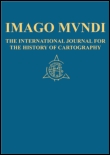
Imago Mundi-The International Journal for the History of Cartography
Scope & Guideline
Illuminating the past through the lens of cartography.
Introduction
Aims and Scopes
- Historical Analysis of Cartography:
The journal focuses on the historical development of cartography, offering insights into how maps have evolved over different periods and cultures, including their role in shaping perceptions of space and territory. - Interdisciplinary Approaches:
Imago Mundi employs interdisciplinary methodologies, integrating perspectives from history, geography, art, and cultural studies to explore the significance of maps beyond their functional uses. - Cultural Significance of Maps:
The journal examines the cultural implications of cartography, including how maps reflect societal values, power dynamics, and artistic expressions, thereby contributing to understanding cultural heritage. - Technological Innovations in Mapping:
A focus on the evolution of mapping technologies, from traditional cartographic techniques to modern digital cartography, highlights the ongoing transformation of how spatial information is represented. - Global Perspectives on Cartography:
Imago Mundi emphasizes a global viewpoint, addressing maps and mapping practices from various regions and historical contexts, thereby fostering a comprehensive understanding of world cartography.
Trending and Emerging
- Participatory and Community Mapping:
The rise of participatory mapping practices, especially in Latin America, signifies a growing interest in how communities use maps for social justice and empowerment, reflecting broader societal movements. - Digital Cartography and Data Visualization:
There is an increasing focus on digital cartography and the use of data visualization techniques, emphasizing the importance of technology in shaping contemporary mapping practices and accessibility. - Environmental and Social Justice Mapping:
Emerging themes include the use of cartography for environmental advocacy and social justice, highlighting how maps can serve as tools for activism and raising awareness about pressing global issues. - Exploration of Underrepresented Regions:
Recent studies are increasingly focusing on maps from underrepresented regions and cultures, expanding the journal's scope to include diverse cartographic traditions and narratives. - Cultural Representations in Cartography:
There is a growing trend towards analyzing the cultural representations embedded in maps, exploring how artistic and aesthetic choices reflect societal values and historical contexts.
Declining or Waning
- Traditional Military Mapping:
There has been a noticeable decrease in the focus on military cartography, which previously garnered significant attention, indicating a shift towards more diverse applications of mapping in contemporary research. - Static, Non-Interactive Maps:
The journal has seen a decline in papers centered on static maps, as the field increasingly embraces dynamic and interactive mapping methods, particularly in digital formats. - Single-Country Case Studies:
Research focusing solely on the cartography of individual countries is becoming less frequent, with a growing preference for comparative studies that examine cartographic practices across multiple cultures. - Historical Maps without Contextual Analysis:
Papers presenting historical maps without in-depth contextual analysis are waning, as there is a rising demand for studies that connect historical maps to broader social, political, and cultural narratives.
Similar Journals

Cuadernos de Prehistoria y Arqueologia-Universidad Autonoma de Madrid
Fostering Dialogue on Our Shared PastCuadernos de Prehistoria y Arqueologia-Universidad Autonoma de Madrid is a distinguished academic journal dedicated to the fields of archaeology and prehistory, published by the Universidad Autonoma de Madrid, Departamento de Prehistoria y Arqueología. With an ISSN of 0211-1608, this journal plays a crucial role in disseminating significant research findings and theoretical advancements within these domains. Recognized for its scholarly excellence, it holds impressive quartile rankings in 2023, including Q2 in Archaeology and Q1 in History, reflecting its high impact within the academic community. While currently not an open-access publication, Cuadernos de Prehistoria y Arqueologia provides valuable insights to researchers, professionals, and students engaged in the exploration of human history and cultural heritage from 2018 to 2024 and beyond. With a commitment to fostering interdisciplinary dialogue, this journal serves as an essential platform for innovative studies and comprehensive reviews, contributing to the advancement of knowledge in archaeology and prehistory.
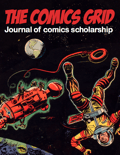
Comics Grid-Journal of Comics Scholarship
Exploring the Intersection of Narrative and Visual ArtThe Comics Grid: Journal of Comics Scholarship is a distinguished open-access journal published by the Open Library of Humanities, dedicated to advancing scholarly discourse in the fields of comics studies, visual arts, and literary theory. Established in 2011, this journal provides a platform for innovative research and critical analysis, exploring the intersection of narrative and visual art forms within comic culture. With an impressive Scopus ranking placing it in the 84th percentile for Literature and Literary Theory and the 75th percentile for Visual Arts and Performing Arts, the journal reflects its commitment to high-quality scholarship. The Comics Grid is particularly impactful in fostering an academic community around comics, making it an essential resource for researchers, professionals, and students interested in the multifaceted dimensions of comics as a medium. Its accessible open-format ensures that vital research is available to a global audience, further enhancing the visibility and impact of comics scholarship.

Navigator-Subsidios para a Historia Maritima do Brasil
Illuminating Brazil's Seafaring StoriesNavigating maritime history in Brazil, the journal Navigador-Subsidios para a Historia Maritima do Brasil serves as a pivotal platform for scholars, researchers, and enthusiasts alike. Published by the Ministerio Marinha, Serv Documentacao Geral Marinha, this esteemed journal has been offering Open Access content since 2005, ensuring that valuable insights into Brazil's rich maritime heritage are accessible to a global audience. Featuring a wide range of scholarly articles, the journal addresses various aspects of maritime history, including naval exploration, trade routes, and the cultural impact of seafaring on Brazilian society. By continually contributing to academic discourse, Navigador plays an essential role in preserving and promoting Brazilian maritime heritage, appealing to professionals in history, maritime studies, and cultural research.

Geodetski List
Connecting Experts in Geospatial Research and DiscoveryGeodetski List is a prestigious journal published by the Croatian Geodetic Society, focusing on the field of geodesy within Earth and Planetary Sciences. Since its inception, the journal has become a vital resource for researchers, professionals, and students who are keen to explore advancements and innovations in geodetic science. With a broad scope encompassing theoretical and applied aspects, Geodetski List provides a platform for disseminating research findings, case studies, and technical developments, facilitating knowledge exchange among geospatial experts. The journal has been indexed from 1979 to 1983, 1985, and from 2008 to 2024, maintaining a respectable standing within the academic community, as evidenced by its classification in the Q3 quartile for 2023. Although not open access, the journal represents an invaluable asset for its audience, aiding in the understanding of geodetic practices, methodologies, and technological advancements. Located in Zagreb, Croatia, it is dedicated to promoting robust scholarship in geodesy and its applications.
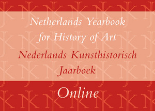
Netherlands Yearbook for History of Art-Nederlands Kunsthistorisch Jaarboek
Connecting Past and Present in Artistic DiscourseThe Netherlands Yearbook for History of Art-Nederlands Kunsthistorisch Jaarboek, published by BRILL, serves as a critical platform for scholarly discourse in the field of art history, specifically focusing on visual arts and performing arts. With an ISSN of 0169-6726 and an E-ISSN of 2214-5966, this journal fosters a deeper understanding of historical contexts and contemporary issues within the art sector. Although currently categorized in the Q4 quartile of Visual Arts and Performing Arts, it provides valuable insights and promotes interdisciplinary studies that enrich the academic narrative surrounding art history. Researchers, professionals, and students alike will find this journal instrumental in accessing rigorous peer-reviewed articles, case studies, and critical essays that span converged years from 2002 to 2003, 2005 to 2006, 2008 to 2011, 2013 to 2017, and 2019 to 2022. As the realm of art history continues to evolve, this publication remains a vital resource for exploring the cultural significance and historical legacy of artistic practice.

Vestnik Sankt-Peterburgskogo Universiteta-Iskusstvovedenie
Celebrating the Intersections of History and Artistic InnovationVestnik Sankt-Peterburgskogo Universiteta-Iskusstvovedenie, published by ST PETERSBURG UNIV PRESS, is a distinguished academic journal based in the Russian Federation, focusing on the interconnected disciplines of Conservation, History, Music, and Visual Arts and Performing Arts. With an ISSN of 2221-3007 and E-ISSN of 2542-2243, this journal plays a vital role in disseminating scholarly research and fostering dialogue across these fields. Despite being categorized in the third quartile (Q3) in 2023 across its respective disciplines, its significance lies in publishing emerging research and critical analyses that contribute to the academic discourse. The journal accepts submissions until the converged years spanning 2016 to 2024, making it a relevant platform for current academic inquiry. Although it currently does not offer open access, the journal provides robust insights for researchers, professionals, and students eager to explore the nuances of cultural heritage and artistic expression. As it continues to develop its impact within the arts and humanities, Vestnik Sankt-Peterburgskogo Universiteta-Iskusstvovedenie remains an essential resource for those passionate about understanding and preserving the rich tapestry of artistic endeavors.
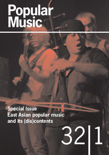
Popular Music
Fostering Dialogue Through Melodic InsightsPopular Music, published by Cambridge University Press, is a leading academic journal that has been at the forefront of contemporary music studies since its inception in 1981. With its comprehensive scope encompassing a rich diversity of topics within the fields of Cultural Studies and Music, this journal holds a respectable Q2 ranking in both categories as of 2023, underscoring its significant impact on the scholarly discourse surrounding popular music. Researchers, professionals, and students alike will find invaluable insights within its pages as it explores the socio-cultural dynamics of music from various global perspectives. While it is not an open-access journal, the publication aims to foster critical dialogue and interdisciplinary scholarship. Based in the United Kingdom, Popular Music serves as a vital resource for those interested in the intersections of music, culture, and society, sustaining a vibrant academic community through rigorous peer-reviewed articles and reviews. Engage with the latest research and deepen your understanding of popular music's ever-evolving landscape.

IEEE ANNALS OF THE HISTORY OF COMPUTING
Tracing the Threads of Technological ProgressIEEE Annals of the History of Computing is a distinguished journal published by the IEEE Computer Society, dedicated to the exploration and documentation of the historical development of computing technologies and their profound impact on society and culture. With an ISSN of 1058-6180 and an E-ISSN of 1934-1547, this journal has been instrumental in providing critical insights into the evolution of computer science and the philosophical questions surrounding technology. While it operates under a non-open access model, its contributions are significant, as evidenced by its rankings in Scopus, where it holds the 93rd position in the Arts and Humanities category and 209th in Computer Science. Spanning from 1992 to 2024, it serves as a crucial platform for scholars and practitioners alike, facilitating a deeper understanding of the historical contexts that shape modern computational practices. With a current category quartile of Q4 in the miscellaneous field of Computer Science and Q3 in the History and Philosophy of Science, the journal continues to foster scholarly discourse, making it essential reading for anyone interested in the intersection of technology history and its philosophical implications.
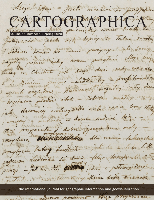
Cartographica
Mapping the Future of Geospatial SciencesCartographica is a premier academic journal dedicated to the field of cartography and geospatial sciences, published by University of Toronto Press Inc. This esteemed journal, with an ISSN of 0317-7173 and an E-ISSN of 1911-9925, serves as a critical platform for researchers and practitioners in the Earth-Surface Processes category, currently positioned in the Q3 quartile with a rank of #99 out of 179 in its field, reflecting its growing influence and relevance among peers. Since its inception in 1980, Cartographica has been committed to advancing the study of cartography through innovative research, critical analysis, and comprehensive review of developments in mapping technologies and applications within the geospatial sciences. Although not an open-access journal, it offers valuable insights and research findings that significantly enhance the understanding and practices within this specialized domain. Researchers, professionals, and students alike will find Cartographica to be an essential resource for staying abreast of the latest trends and methodologies in cartographic research.
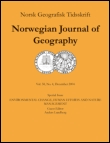
Norsk Geografisk Tidsskrift-Norwegian Journal of Geography
Illuminating the landscape of geographical research.Norsk Geografisk Tidsskrift-Norwegian Journal of Geography, published by Routledge Journals, Taylor & Francis Ltd, is a pivotal peer-reviewed journal that has been instrumental in advancing the field of geography since its inception in 1926. With an esteemed Q2 ranking in both Earth and Planetary Sciences and Geography, Planning and Development categories, it serves as a vital resource for researchers, professionals, and students seeking to deepen their understanding of geographical phenomena. The journal's rich historical archive, covering significant periods in geography and environmental studies, showcases a diverse array of articles that reflect ongoing research trends and challenges within the field. Despite not offering Open Access, its impactful content remains accessible through institutional subscriptions, underscoring the journal's commitment to advancing geographical research and fostering scholarly dialogue. As it continues to publish high-quality research, Norsk Geografisk Tidsskrift stands as a key player in geographical scholarship, reinforcing its importance within the academic community.